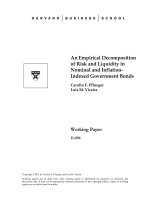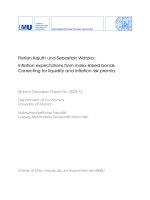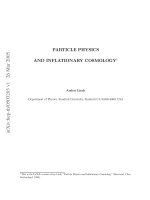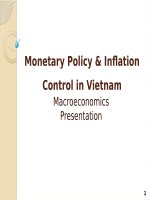GDP, Unemployment and Inflation
Bạn đang xem bản rút gọn của tài liệu. Xem và tải ngay bản đầy đủ của tài liệu tại đây (464.9 KB, 64 trang )
Thinking Like an Economist
Economics
Economics
is a social science which
attempts to explain the behavior and
interactions of economic actors in
terms of the items of value they
exchange.
Actors = individuals, households,
firms, industries, governments or
countries
Economics
Economic
Models:
Reasoning
a model or theory is a
framework that helps us to
understand relationships between
cause and effect. They are a
simplification of reality.
Basic Questions: Micro
Microeconomic
What
Questions
should we produce?
How should we produce?
For whom should we produce?
Basic Questions: Macro
Macroeconomic
How
Questions
can sufficient growth be attained
so that the well being of society
increases?
How should productive capacity be
utilized so that there will be full
employment with stable prices?
The Economy as a Circular
Flow
Resources
Income
Firms
Households
Expenditures
Goods and Services
Savings and Investment
Income
Firms
Investment
Households
Expenditures
Borrowings
Financial Markets
Savings
Financial Markets
Savers
Individuals
Businesses
Government
Financial Intermediaries
Banks
Pension funds
Mutual funds
Borrowers
Individuals
Businesses
Government
Financial Intermediaries
Financial intermediaries include banks,
insurance companies, investment
companies, etc
Financial intermediaries act as the gobetween in arrangements between savers
and borrowers.
They reduce the uncertainty facing
individual households or businesses
through diversification.
Financial Market:
Participants
The
suppliers of credit or loanable
funds:
Household
Sector
Business Sector
Foreign Sector
Government Sector
Financial Market: Participants
The
demanders of credit or
loanable funds:
Government
Sector
Business Sector
Foreign Sector
Household Sector
Interest Rates: Facts
Interest
rates serve many roles:
Interest
rates are the price of
credit.
Interest rates are a premium paid
to forego consumption.
Interest rates are the return to
capital as a factor of production.
Real and Nominal Rates
Nominal
interest rates are rates
unadjusted for the effect of
inflation or deflation.
Real rates are adjusted for price
level changes.
Inflation and Interest Rates
Nominal
variables are not adjusted to
reflect changes in the price level.
They
are the percentage by which
the money a borrower pays back
exceeds the money he borrowed,
making no adjustment for any
change in purchasing power.
Inflation and Interest Rates
Real
interest rates are the percentage
increase in purchasing power that the
borrower pays to the lender for the
privilege of borrowing.
Real interest rates are nominal interest
rates minus the rate of inflation.
Real interest rates may be positive, zero,
or negative.
Nominal Rates: The Fisher
Effect
THE FISHER EFFECT:
NOMINAL RATE
=
REAL RATE +
EXPECTED INFLATION
Circular Flow with
Government
Income
Firms
Households
Investment
Taxes
Government
Purchases of
Goods and Services
Subsidies
Borrowing
Expenditures
Taxes
Government
Government
Government
Government Salaries
and Transfers
Borrowing
Saving
Financial Markets
Savings
The Role of Government:
Market Failure
Inequity
Standards
of fairness are determined
by society and may not be met by
the market’s distribution of benefits.
Failure
of Competition
Markets
•
•
may not be competitive.
Regulation
Anti-trust
The Role of Government:
Market Failure
Public
Goods
Some goods cannot be produced
profitably by the private market and as a
result must be provided by government.
•
Free Rider Problem
Externalities
Some activities provide benefits or impose
costs on others that are not captured by the
the price system.
The Role of Government:
Market Failure
Underutilized
Resources
Macroeconomic
•
•
Fiscal Policy
Monetary Policy
stabilization
Circular Flow with Government and
the Rest of Foreign
the World
Countries
Foreign Borrowing
Foreign Savings
Exports
Investment
Imports
Income
Households
Firms
Taxes
Government
Purchases of
Goods and Services
Subsidies
Borrowing
Expenditures
Taxes
Government
Government
Government
Borrowing
Saving
Financial Markets
Government Salaries
and Transfers
Savings
The Rest of the World
An
economy has two basic kinds of
economic interactions with the rest
of the world.
Buying
and selling goods and
services
Buying and selling assets.
The Rest of the World
Exports
are those goods we produce
for sale in the rest of the world.
Imports are those goods we buy from
the rest of the world.
We also lend to the rest of the world
and borrow from them.
Measuring GDP
What Is GDP?
GDP, Gross Domestic Product, is the
total dollar value of all final goods and
services produced in a country during a
year.
Current market prices are used to
aggregate different outputs to a dollar
total.
Government purchases, many of which do
not occur in markets, are valued at their
cost of production.









